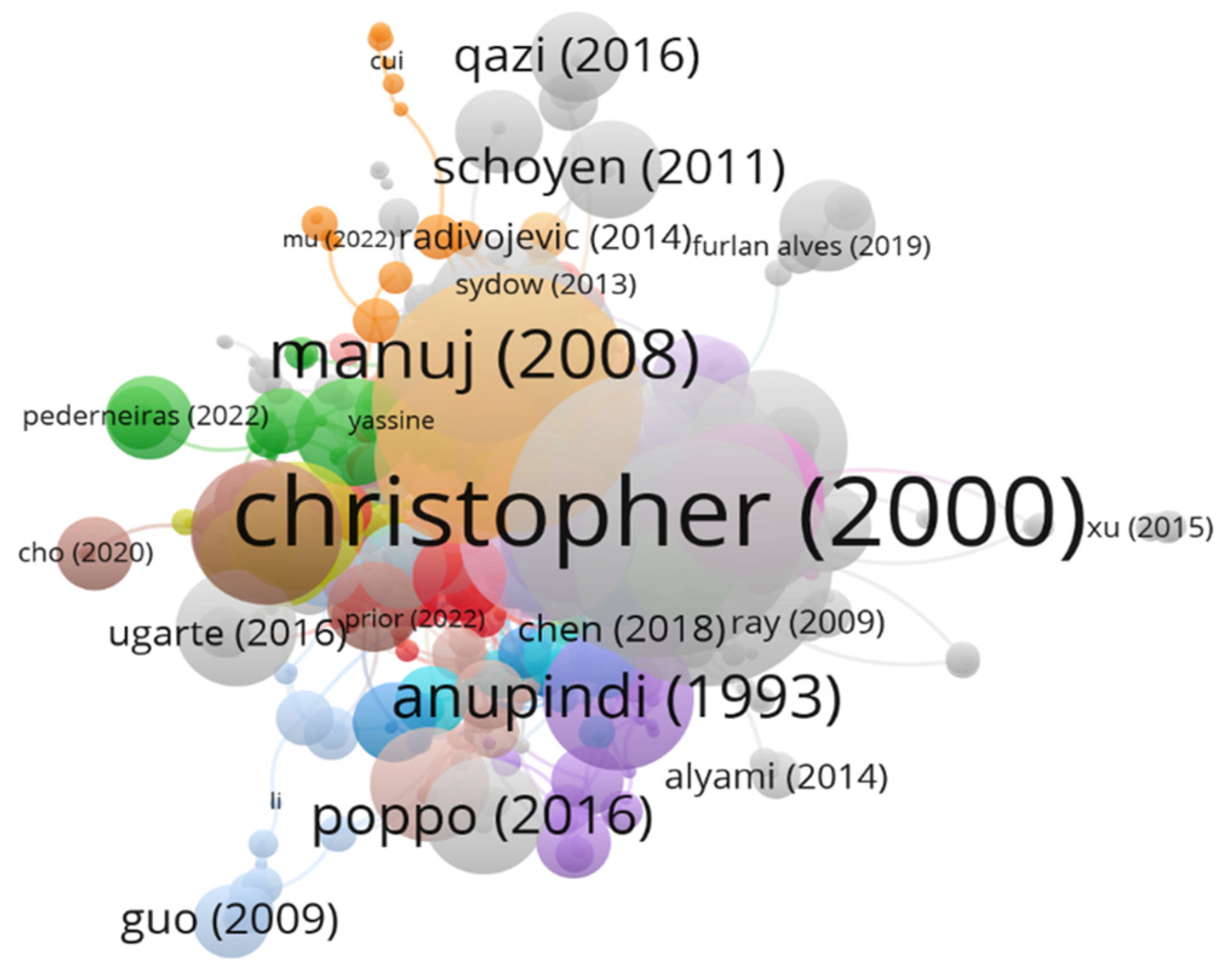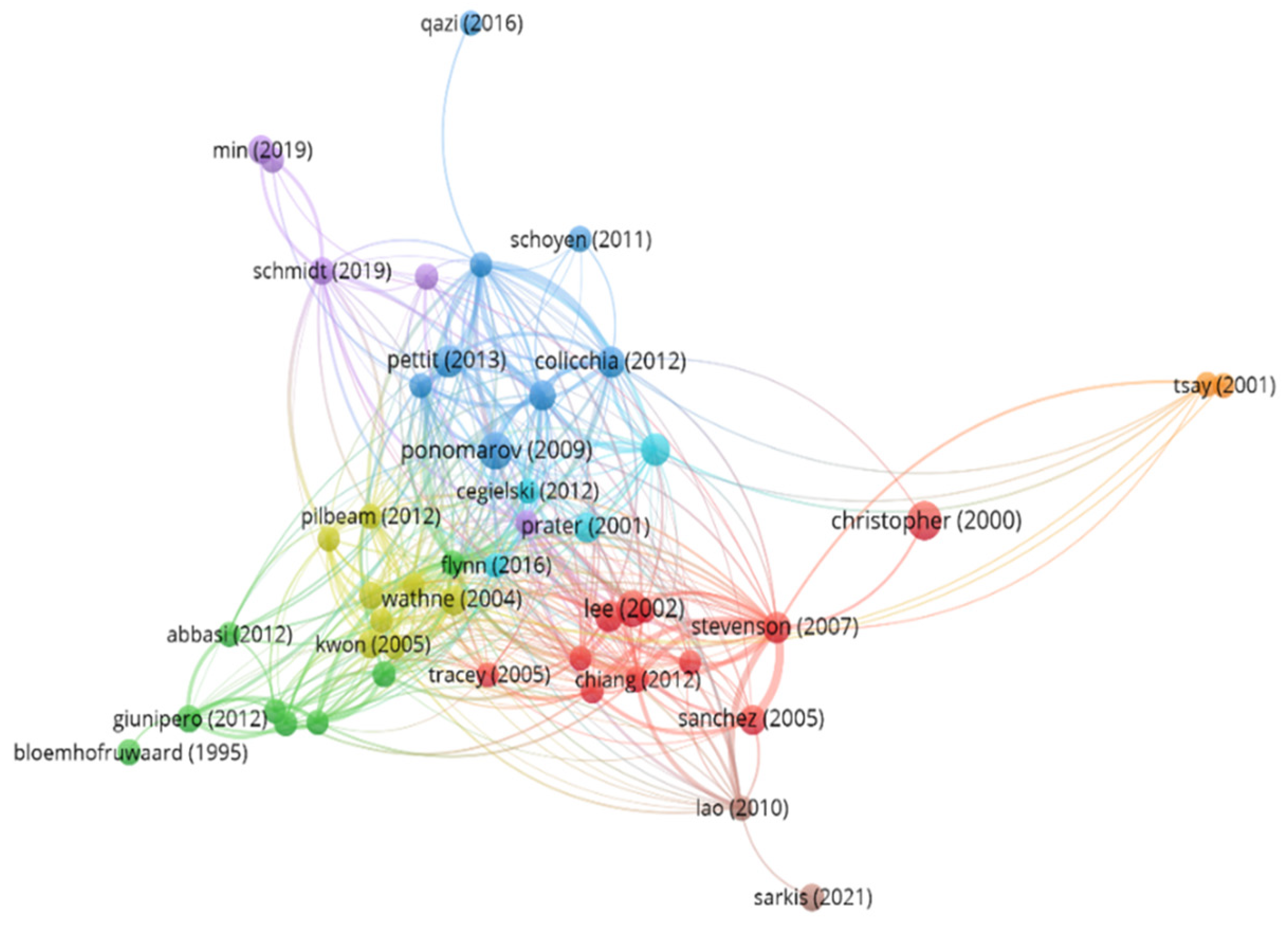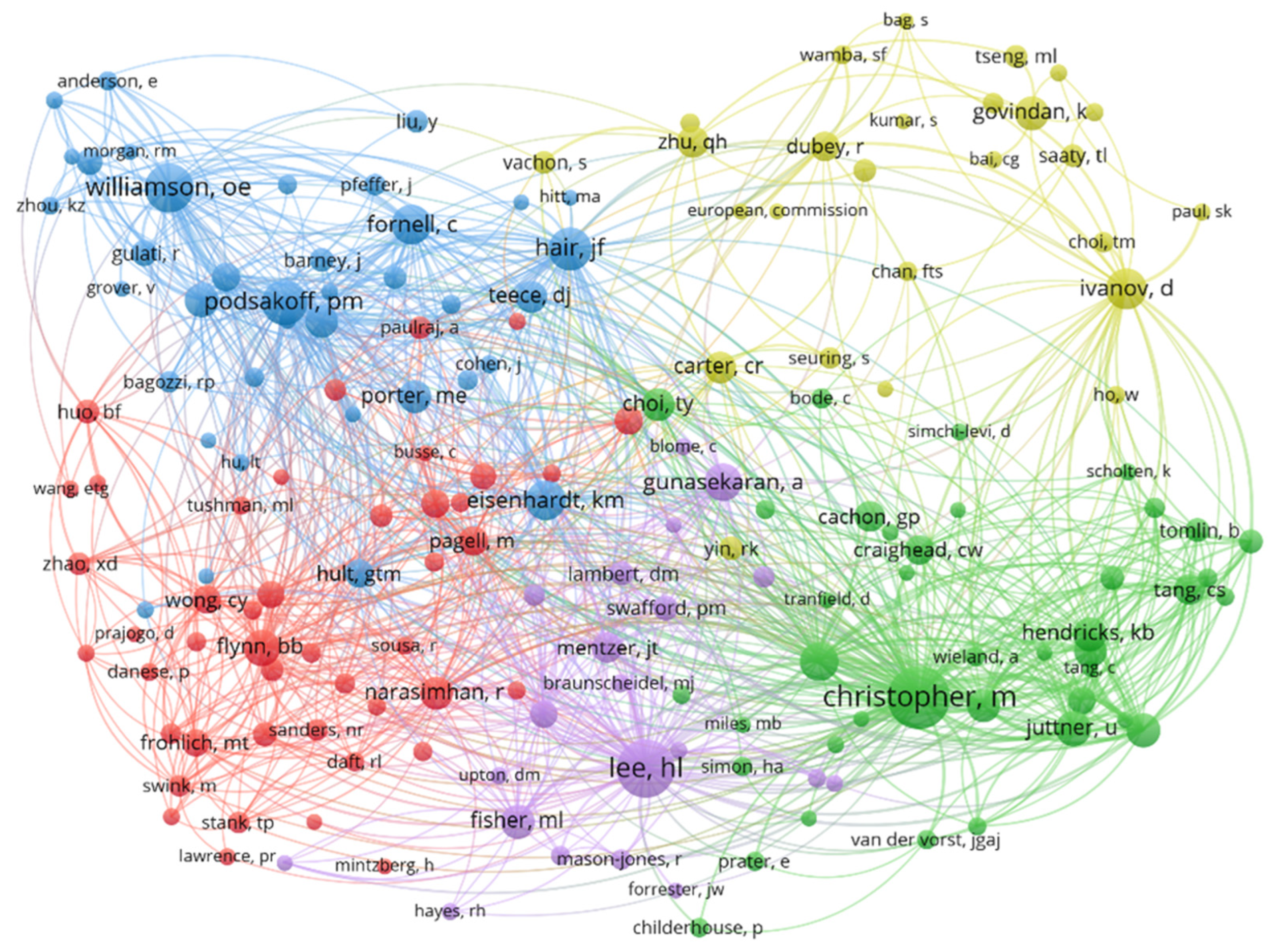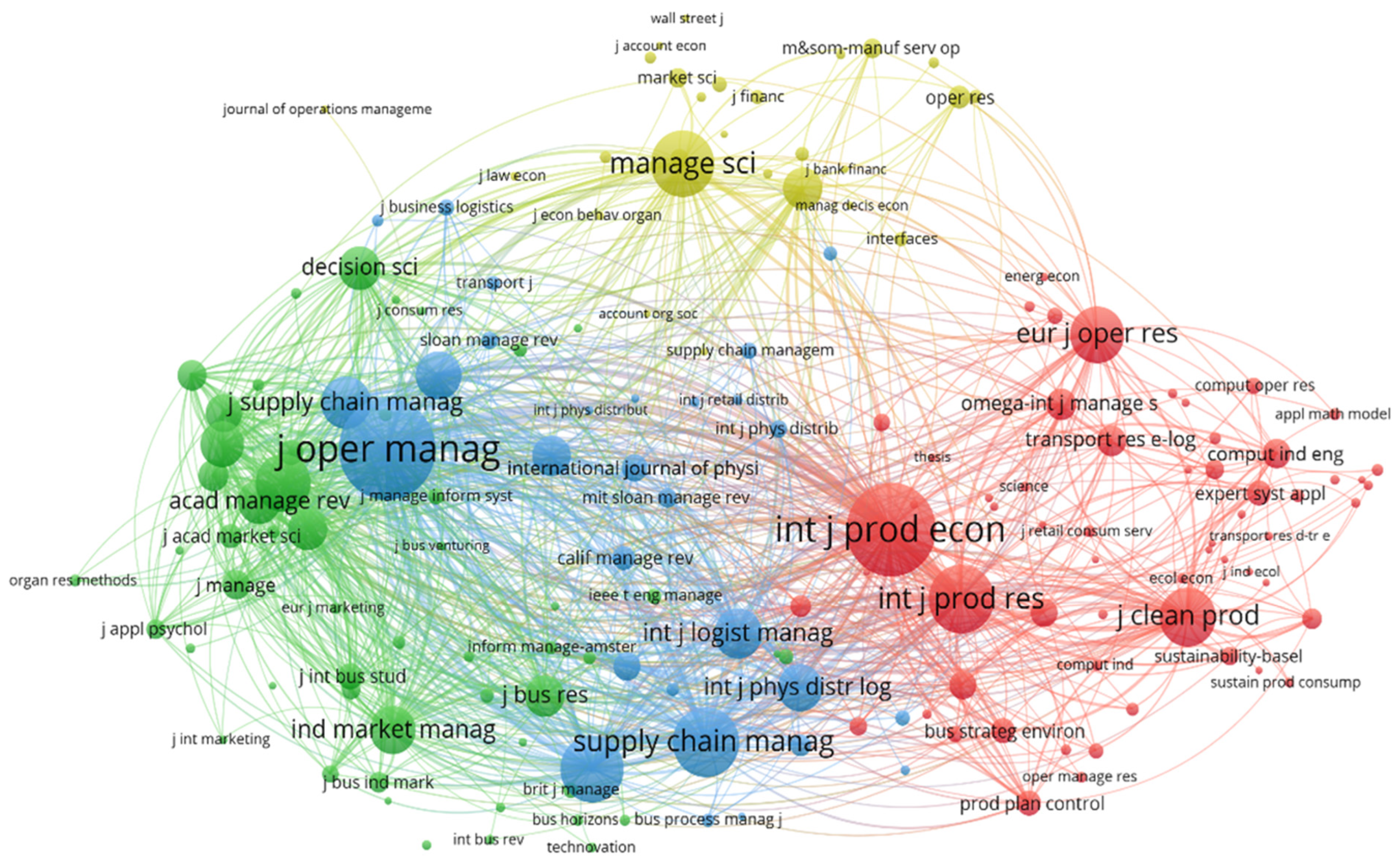What Have We Learned? A Bibliometric Review of a Three-Decade Investigation into the Supply Chain Uncertainty and a Revised Framework to Cope with the Challenges
Abstract
:1. Introduction
2. Methodology
2.1. Search Strategies
2.2. Finding Analysis
3. Results
3.1. Performance Analysis
3.2. Science Mapping Analysis
4. Discussion: Literature Clustering
4.1. Cluster 1: Overall Impact of Uncertainty
4.2. Cluster 2: Demand Uncertainty
4.3. Cluster 3: Challenges Uncertainty
4.4. Cluster 4: Uncertain Strategy
5. Conclusions
Funding
Institutional Review Board Statement
Informed Consent Statement
Data Availability Statement
Conflicts of Interest
References
- Sarkis, J. Supply chain sustainability: Learning from the COVID-19 pandemic. Int. J. Oper. Prod. Manag. 2021, 41, 63–73. [Google Scholar] [CrossRef]
- Yin, X.; Büyüktahtakın, E.; Patel, B.P. COVID-19: Data-Driven optimal allocation of ventilator supply under uncertainty and risk. Eur. J. Oper. Res. 2023, 304, 255–275. [Google Scholar] [CrossRef]
- Fattahi, M.; Keyvanshokooh, E.; Kannan, D.; Govindan, K. Resource planning strategies for healthcare systems during a pandemic. Eur. J. Oper. Res. 2023, 304, 192–206. [Google Scholar] [CrossRef] [PubMed]
- Nikian, A.; Khademi Zare, H.; Lotfi, M.M.; Fallah Nezhad, M.S. Redesign of a sustainable and resilient closed-loop supply chain network under uncertainty and disruption caused by sanctions and COVID-19. Oper. Manag. Res. 2022, 16, 1019–1042. [Google Scholar] [CrossRef]
- Kumar, P.; Kumar Singh, R. Strategic framework for developing resilience in Agri-Food Supply Chains during COVID 19 pandemic. Int. J. Logist. Res. Appl. 2022, 25, 1401–1424. [Google Scholar] [CrossRef]
- Liu, C.-Y.; Lee, C.-Y. Multiple supply chain adoption under uncertainty. Int. J. Phys. Distrib. Logist Manag. 2019, 49, 305–326. [Google Scholar] [CrossRef]
- Singh, N.P. Managing environmental uncertainty for improved firm financial performance: The moderating role of supply chain risk management practices on managerial decision making. Int. J. Logist. Res. Appl. 2020, 23, 270–290. [Google Scholar] [CrossRef]
- Zimmermann, R.; Ferreira, L.M.D.F.; Moreira, A.C. An empirical analysis of the relationship between supply chain strategies, product characteristics, environmental uncertainty and performance. Supply Chain. Manag. 2020, 25, 375–391. [Google Scholar] [CrossRef]
- Gultekin, B.; Demir, S.; Gunduz, M.A.; Cura, F.; Ozer, L. The logistics service providers during the COVID-19 pandemic: The prominence and the cause-effect structure of uncertainties and risks. Comput. Ind. Eng. 2022, 165, 107950. [Google Scholar] [CrossRef]
- Yang, M.; Lim, M.K.; Qu, Y.; Ni, D.; Xiao, Z. Supply chain risk management with machine learning technology: A literature review and future research directions. Comput. Ind. Eng. 2023, 175, 108859. [Google Scholar] [CrossRef]
- Yazdani, M.; Pamucar, D.; Chatterjee, P.; Torkayesh, A.E. A multi-tier sustainable food supplier selection model under uncertainty. Oper. Manag. Res. 2022, 15, 116–145. [Google Scholar] [CrossRef]
- Calafiore, G.C.; Parino, F.; Zino, L.; Rizzo, A. Dynamic planning of a two-dose vaccination campaign with uncertain supplies. Eur. J. Oper. Res. 2023, 304, 1269–1278. [Google Scholar] [CrossRef]
- Roscoe, S.; Skipworth, H.; Aktas, E.; Habib, F. Managing supply chain uncertainty arising from geopolitical disruptions: Evidence from the pharmaceutical industry and brexit. Int. J. Oper. Prod. Manag. 2020, 40, 1499–1529. [Google Scholar] [CrossRef]
- Roscoe, S.; Aktas, E.; Petersen, K.; Skipworth, H.; Handfield, R.; Habib, F. Redesigning global supply chains during compounding geopolitical disruptions: The role of supply chain logics. Int. J. Oper. Prod. Manag. 2023, 42, 1407–1434. [Google Scholar] [CrossRef]
- Bendoly, E.; Boyer, K.; Craig, N.; Paul, S. Pulled in opposite directions: A joint consideration of supply and demand uncertainty in supply chain decision-making. J. Bus. Logist. 2022, 43, 448–471. [Google Scholar] [CrossRef]
- Weisz, E.; Herold, D.M.; Kummer, S. Revisiting the bullwhip effect: How can AI smoothen the bullwhip phenomenon? Int. J. Logist. Manag. 2023. Published online. [Google Scholar] [CrossRef]
- Naim, M.M.; Gosling, J.; Hewlett, B. Rethinking infrastructure supply chain management–a manifesto for change. Int. J. Logist. Res. Appl. 2022, 25, 1359–1380. [Google Scholar] [CrossRef]
- Hajiagha, S.H.R.; Mahdiraji, H.A.; Behnam, M.; Nekoughadirli, B.; Joshi, R. A scenario-based robust time–cost tradeoff model to handle the effect of COVID-19 on supply chains project management. Oper. Manag. Res. 2022, 15, 357–377. [Google Scholar] [CrossRef]
- Abdul-Hamid, A.-Q.; Ali, M.H.; Osman, L.H.; Tseng, M.-L.; Lim, M.K. Industry 4.0 quasi-effect between circular economy and sustainability: Palm oil industry. Int. J. Prod. Econ. 2022, 253, 108616. [Google Scholar] [CrossRef]
- Lo, S.L.Y.; How, B.S.; Teng, S.Y.; Lam, H.L.; Lim, C.H.; Rhamdhani, M.A.; Sunarso, J. Stochastic techno-economic evaluation model for biomass supply chain: A biomass gasification case study with supply chain uncertainties. Renew Sustain. Energy Rev. 2021, 152, 111644. [Google Scholar] [CrossRef]
- Kusrini, N.; Maswadi, M. The performance improvement of sustainable palm oil supply chain management after COVID-19: Priority indicators using F-AHP. Uncertain Supply Chain Manag. 2021, 9, 227–236. [Google Scholar] [CrossRef]
- Page, M.J.; McKenzie, J.E.; Bossuyt, P.; Boutron, I.; Hoffmann, T.C.; Mulrow, C.D.; Shamseer, L.; Tetzlaff, J.M.; Akl, E.A.; Brennan, S.E.; et al. The PRISMA 2020 statement: An updated guideline for reporting systematic reviews. Med. Flum. 2021, 57, 444–465. [Google Scholar] [CrossRef]
- Budler, M.; Župič, I.; Trkman, P. The development of business model research: A bibliometric review. J. Bus. Res. 2021, 135, 480–495. [Google Scholar] [CrossRef]
- Tseng, M.-L.; Chang, C.H.; Lin, C.W.R.; Wu, K.J.; Chen, Q.; Xia, L.; Xue, B. Future trends and guidance for the triple bottom line and sustainability: A data driven bibliometric analysis. Environ. Sci. Pollut. Res. 2020, 27, 33543–33567. [Google Scholar] [CrossRef] [PubMed]
- Hashemi, H.; Rajabi, R.; Brashear-Alejandro, T.G. COVID-19 research in management: An updated bibliometric analysis. J. Bus. Res. 2022, 149, 795–810. [Google Scholar] [CrossRef]
- Moher, D.; Liberati, A.; Tetzlaff, J.; Altman, D.G.; PRISMA Group. Preferred Reporting Items for Systematic Reviews and Meta-Analyses: The PRISMA Statement. Ann. Intern. Med. 2009, 151, 873–880. [Google Scholar] [CrossRef]
- Larrea-Gallegos, G.; Benetto, E.; Marvuglia, A.; Gutiérrez, T.N. Sustainability, resilience and complexity in supply networks: A literature review and a proposal for an integrated agent-based approach. Sustain. Prod. Consum. 2022, 30, 946–961. [Google Scholar] [CrossRef]
- Bhatt, Y.; Ghuman, K.; Dhir, A. Sustainable manufacturing. Bibliometrics and content analysis. J. Clean Prod. 2020, 260, 120988. [Google Scholar] [CrossRef]
- Mukherjee, D.; Lim, W.M.; Kumar, S.; Donthu, N. Guidelines for advancing theory and practice through bibliometric research. J. Bus. Res. 2022, 148, 101–115. [Google Scholar] [CrossRef]
- Pizzi, S.; Caputo, A.; Corvino, A.; Venturelli, A. Management research and the UN sustainable development goals (SDGs): A bibliometric investigation and systematic review. J. Clean Prod. 2020, 276, 124033. [Google Scholar] [CrossRef]
- Donthu, N.; Kumar, S.; Mukherjee, D.; Pandey, N.; Lim, W.M. How to conduct a bibliometric analysis: An overview and guidelines. J. Bus. Res. 2021, 133, 285–296. [Google Scholar] [CrossRef]
- Christopher, M. The agile supply chain—Competing in volatile markets. Ind. Mark. Manag. 2000, 29, 37–44. [Google Scholar] [CrossRef]
- Ponomarov, S.Y.; Holcomb, M.C. Understanding the Concept of Supply Chain Resilience. Int. J. Logist. Manag. 2009, 20, 124–143. [Google Scholar] [CrossRef]
- Lee, H.L. Alignling supply chain strategies with product uncertainties. Calif. Manag. Rev. 2002, 44, 105–119. [Google Scholar] [CrossRef]
- Min, H. Blockchain technology for enhancing supply chain resilience. Bus. Horiz. 2019, 62, 35–45. [Google Scholar] [CrossRef]
- Fornell, C.; Larcker, D.F. Evaluating structural equation models with unobservable variables and measurement error. J. Mark. Res. 1981, 18, 39–50. [Google Scholar] [CrossRef]
- Podsakoff, P.M.; MacKenzie, S.B.; Lee, J.Y.; Podsakoff, N.P. Common Method Biases in Behavioral Research: A Critical Review of the Literature and Recommended Remedies. J. Appl. Psychol. 2003, 88, 879–903. [Google Scholar] [CrossRef]
- Armstrong, J.S.; Overton, T.S. Estimating Nonresponse Bias in Mail Surveys. J. Mark. Res. 1977, 14, 396–402. [Google Scholar] [CrossRef]
- Cui, L.; Wu, H.; Lang, X.; Li, Y. Exploring circular supply chain practices from a dual perspective: Using a hybrid method under uncertainty. Int. J. Logist. Res. Appl. 2021, 1–24. [Google Scholar] [CrossRef]
- Qazi, A.; Quigley, J.; Dickson, A.; Kirytopoulos, K. Project Complexity and Risk Management (ProCRiM): Towards modelling project complexity driven risk paths in construction projects. Int. J. Proj. Manag. 2016, 34, 1183–1198. [Google Scholar] [CrossRef]
- Schøyen, H.; Bråthen, S. The Northern Sea Route versus the Suez Canal: Cases from bulk shipping. J. Transp. Geogr. 2011, 19, 977–983. [Google Scholar] [CrossRef]
- Radivojević, G.; Gajović, V. Supply chain risk modeling by AHP and Fuzzy AHP methods. J. Risk Res. 2014, 17, 337–352. [Google Scholar] [CrossRef]
- Münch, C.; von der Gracht, H.A.; Hartmann, E. The future role of reverse logistics as a tool for sustainability in food supply chains: A Delphi-based scenario study. Supply Chain. Manag. Int. J. 2022. ahead-of-print. [Google Scholar] [CrossRef]
- Furlan Alves, M.B.; de Sousa Jabbour, A.B.L.; Mariano, E.B. How can we solve the puzzle of strategic climate management and appreciate its long-term effects? J. Organ. Chang. Manag. 2019, 32, 687–708. [Google Scholar] [CrossRef]
- Sydow, J.; Frenkel, S.J. Labor, risk, and uncertainty in global supply networks—Exploratory insights. J. Bus. Logist. 2013, 34, 236–247. [Google Scholar] [CrossRef]
- Manuj, I.; Mentzer, J.T. Global supply chain risk management. J. Bus. Logist. 2008, 29, 133–155. [Google Scholar] [CrossRef]
- Pederneiras, Y.M.; Meckenstock, J.; Carvalho, A.I.C.; Barbosa-Póvoa, A.P. The wicked problem of sustainable development in supply chains. Bus. Strategy Environ. 2022, 31, 46–58. [Google Scholar] [CrossRef]
- Yassine, N. Inventory planning under supplier uncertainty in a two-level supply chain. Int. J. Logist. Manag. 2023, 34, 497–516. [Google Scholar] [CrossRef]
- Cho, Y.J.; Kim, Y.; Zang, Y. Information externalities and voluntary disclosure: Evidence from a major customer’s earnings announcement. Account. Rev. 2020, 95, 73–96. [Google Scholar] [CrossRef]
- Xu, Y.; Patnayakuni, R.; Tao, F.; Wang, H. Incomplete interval fuzzy preference relations for supplier selection in supply chain management. Technol. Econ. Dev. Econ. 2015, 21, 379–404. [Google Scholar] [CrossRef]
- Chen, M.; Liu, H.; Wei, S.; Gu, J. Top managers’ managerial ties, supply chain integration, and firm performance in China: A social capital perspective. Ind. Mark. Manag. 2018, 74, 205–214. [Google Scholar] [CrossRef]
- Ray, G.; Wu, D.; Konana, P. Competitive environment and the relationship between IT and vertical integration. Inf. Syst. Res. 2009, 20, 585–603. [Google Scholar] [CrossRef]
- Prior, D.D.; Mudiyanselage, L.K.H.; Hussain, O.K. Does formalization or centralization mitigate uncertainty in knowledge-intensive procurement? J. Bus. Ind. Mark. 2022, 37, 433–446. [Google Scholar] [CrossRef]
- Ugarte, G.M.; Golden, J.S.; Dooley, K.J. Lean versus green: The impact of lean logistics on greenhouse gas emissions in consumer goods supply chains. J. Purch. Supply Manag. 2016, 22, 98–109. [Google Scholar] [CrossRef]
- Anupindi, R.; Akella, R. Diversification under supply uncertainty. Manag. Sci. 1993, 39, 944–963. [Google Scholar] [CrossRef]
- Alyami, H.; Lee, P.T.-W.; Yang, Z.; Riahi, R.; Bonsall, S.; Wang, J. An advanced risk analysis approach for container port safety evaluation. Marit. Policy Manag. 2014, 41, 634–650. [Google Scholar] [CrossRef]
- Poppo, L.; Zhou, K.Z.; Li, J.J. When can you trust “trust”? Calculative trust, relational trust, and supplier performance. Strateg. Manag. J. 2016, 37, 724–741. [Google Scholar] [CrossRef]
- Stevenson, M.; Spring, M. Flexibility from a supply chain perspective: Definition and review. Int. J. Oper. Prod. Manag. 2007, 27, 685–713. [Google Scholar] [CrossRef]
- Hofer, A.R.; Jin, Y.H.; Knemeyer, A.M. Environmental uncertainty and cross-buying in logistics outsourcing arrangements: A resource dependence perspective. Int. J. Phys. Distrib. Logist. Manag. 2021, 51, 236–258. [Google Scholar] [CrossRef]
- Ngo, V.M.; Nguyen, H.H.; Pham, H.C.; Nguyen, H.M.; Truong, P.V.D. Digital supply chain transformation: Effect of firm’s knowledge creation capabilities under COVID-19 supply chain disruption risk. Oper. Manag. Res. 2022, 16, 1003–1018. [Google Scholar] [CrossRef]
- Kumari, S.; Jeble, S.; Venkatesh, V.G.; Nagarajan, C.; Shi, Y. Antecedents of agriculture supply chain performance during COVID-19: An emerging economy perspective. Oper. Manag. Res. 2022, 16, 489–510. [Google Scholar] [CrossRef]
- Lasso, S.; Cash, P.; Daalhuizen, J.; Kreye, M. Uncertainty and Activity Selection in New Product Development: An Experimental Study. IEEE Trans. Eng. Manag. 2022, 69, 1405–1416. [Google Scholar] [CrossRef]
- Huang, M.C.; Yen, G.F.; Liu, T.C. Reexamining supply chain integration and the supplier’s performance relationships under uncertainty. Supply Chain Manag. 2014, 19, 64–78. [Google Scholar] [CrossRef]
- Harland, C.M.; Knight, L.; Patrucco, A.S.; Lynch, J.; Telgen, J.; Peters, E.; Tátrai, T.; Ferk, P. Practitioners’ learning about healthcare supply chain management in the COVID-19 pandemic: A public procurement perspective. Int. J. Oper. Prod. Manag. 2021, 41, 178–189. [Google Scholar] [CrossRef]
- Li, C.; Wang, Y.; Wu, C. Oil implied volatility and expected stock returns along the worldwide supply chain. Energy Econ. 2022, 114, 106322. [Google Scholar] [CrossRef]
- Srinivasan, M.; Srivastava, P.; Iyer, K.N.S. Response strategy to environment context factors using a lean and agile approach: Implications for firm performance. Eur. Manag. J. 2020, 38, 900–913. [Google Scholar] [CrossRef]
- Zacharia, Z.; Plasch, M.; Mohan, U.; Gerschberger, M. The emerging role of coopetition within inter-firm relationships. Int. J. Logist. Manag. 2019, 30, 414–437. [Google Scholar] [CrossRef]
- Srinivasan, M.; Hamdani, M.; Ma, S. Four supply chain management systems: From supply chain strategies to human resource management. Bus. Horiz. 2021, 64, 249–260. [Google Scholar] [CrossRef]
- Kumar, M.; Raut, R.D.; Sharma, M.; Choubey, V.K.; Paul, S.K. Enablers for resilience and pandemic preparedness in food supply chain. Oper. Manag. Res. 2022, 15, 1198–1223. [Google Scholar] [CrossRef]
- Sanchez-Rodrigues, V.; Potter, A.; Naim, M.M. Evaluating the causes of uncertainty in logistics operations. Int. J. Logist. Manag. 2010, 21, 45–64. [Google Scholar] [CrossRef]
- Baghalian, A.; Rezapour, S.; Farahani, R.Z. Robust supply chain network design with service level against disruptions and demand uncertainties: A real-life case. Eur. J. Oper. Res. 2013, 227, 199–215. [Google Scholar] [CrossRef]
- Yigitbasioglu, O.M. Information Sharing with Key Suppliers: A Transaction Cost Theory Perspective. Int. J. Phys. Distrib. Logist. Manag. 2010, 40, 550–578. [Google Scholar] [CrossRef]
- Montoya-Torres, J.R.; Muñoz-Villamizar, A.; Mejia-Argueta, C. Mapping research in logistics and supply chain management during COVID-19 pandemic. Int. J. Logist. Res. Appl. 2023, 26, 421–441. [Google Scholar] [CrossRef]
- Simangunsong, E.; Hendry, L.C.; Stevenson, M. Managing supply chain uncertainty with emerging ethical issues. Int. J. Oper. Prod. Manag. 2016, 36, 1272–1307. [Google Scholar] [CrossRef]
- Nyamah, E.Y.; Jiang, Y.; Feng, Y.; Enchill, E. Agri-food supply chain performance: An empirical impact of risk. Manag. Decis. 2017, 55, 872–891. [Google Scholar] [CrossRef]
- Du, Y.; Hu, X.; Vakil, K. Systematic literature review on the supply chain agility for manufacturer and consumer. Int. J. Consum. Stud. 2021, 45, 581–616. [Google Scholar] [CrossRef]
- Ning, C.; You, F. Data-driven decision making under uncertainty integrating robust optimization with principal component analysis and kernel smoothing methods. Comput. Chem. Eng. 2018, 112, 190–210. [Google Scholar] [CrossRef]
- Nguyen, H.; Onofrei, G.; Truong, D. Supply chain communication and cultural compatibility: Performance implications in the global manufacturing industry. Bus. Process Manag. J. 2021, 27, 253–274. [Google Scholar] [CrossRef]
- Handfield, R.B.; Graham, G. Corona virus, tariffs, trade wars and supply chain evolutionary design. Int. J. Oper. Prod. Manag. 2020, 40, 1649–1660. [Google Scholar] [CrossRef]
- Üstündağ, A.; Ungan, M.C. Supplier flexibility and performance: An empirical research. Bus. Process Manag. J. 2020, 26, 1851–1870. [Google Scholar] [CrossRef]
- Srinivasan, M.; Mukherjee, D.; Gaur, A.S. Buyer-supplier partnership quality and supply chain performance: Moderating role of risks, and environmental uncertainty. Eur. Manag. J. 2011, 29, 260–271. [Google Scholar] [CrossRef]
- Alexander, A.; Kumar, M.; Walker, H. A Decision Theory Perspective on Complexity in Performance Measurement and Management. Int. J. Oper. Prod. Manag. 2018, 38, 2214–2244. [Google Scholar] [CrossRef]
- Kopanaki, E. Conceptualizing Supply Chain Resilience: The Role of Complex IT Infrastructures. Systems 2022, 10, 35. [Google Scholar] [CrossRef]
- Nandi, M.L.; Nandi, S.; Moya, H.; Kaynak, H. Blockchain technology-enabled supply chain systems and supply chain performance: A resource-based view. Supply Chain Manag. 2020, 25, 841–862. [Google Scholar] [CrossRef]
- Sislian, L.; Jaegler, A. Linkage of blockchain to enterprise resource planning systems for improving sustainable performance. Bus. Strateg. Environ. 2022, 31, 737–750. [Google Scholar] [CrossRef]
- Xiong, Y.; Lam, H.K.; Kumar, A.; Ngai, E.W.; Xiu, C.; Wang, X. The mitigating role of blockchain-enabled supply chains during the COVID-19 pandemic. Int. J. Oper. Prod. Manag. 2021, 41, 1495–1521. [Google Scholar] [CrossRef]
- Luo, B.N.; Yu, K. Fits and misfits of supply chain flexibility to environmental uncertainty: Two types of asymmetric effects on performance. Int. J. Logist. Manag. 2016, 27, 862–888. [Google Scholar] [CrossRef]
- Ramos, E.D.; Patrucco, A.S.; Chaves, M. Dynamic capabilities in the “new normal”: A study of organizational flexibility, integration and agility in the Peruvian coffee supply chain. Supply Chain Manag. An Int. J. 2021, 28, 55–73. [Google Scholar] [CrossRef]








| Timespan (1993–2022) | 884 | Authors | 2335 |
| Sources (Journals) | 176 | Authors of single-authored documents | 2091 |
| Countries | 76 | Authors of multi-authored documents | 244 |
| Keywords Plus (ID) | 1805 | Articles per author | 0.38 |
| Author’s keywords (DE) | 2626 | Authors per article | 2.64 |
| Average publication per year | 29.7 | Collaboration index (single: multi) | 8.60 |
| Average citations per article | 32.2 | Growth rate percentage | 82.5 |
| Journals | Publisher | No of Articles | Citations | Best Rank | Impact Factor (2021) |
|---|---|---|---|---|---|
| Supply Chain Management—An International Journal | Emerald | 75 | 3793 | Q1 | 11.263 |
| International Journal of Operations and Production Management | Emerald | 57 | 2649 | Q1 | 9.360 |
| International Journal of Logistic Management | Emerald | 56 | 2401 | Q2 | 5.446 |
| Decision Sciences | Wiley | 48 | 1436 | Q3 | 4.551 |
| International Journal of Logistics-Research and Applications | Taylor & Francis | 38 | 563 | Q2 | 5.992 |
| International Journal of Physical Distribution and Logistics Management | Emerald | 28 | 878 | Q1 | 7.290 |
| Industrial Marketing Management | Elsevier | 24 | 1966 | Q1 | 8.890 |
| Journal of Business and Industrial Marketing | Emerald | 24 | 211 | Q3 | 3.319 |
| Journal of Business Logistics | Wiley | 21 | 1148 | Q1 | 7.875 |
| Operations Management Research | Springer | 21 | 172 | Q1 | 7.032 |
| Authors | Affiliation | Publications (First Authors) | H-Index | i-10 Index |
|---|---|---|---|---|
| Yu, Kangkang | Renmin University of China (China) | 7 (5) | 17 | 29 |
| Craighead, Christopher W. | University of Tennessee (USA) | 6 (1) | 37 | 58 |
| Shi, Yangyan | Macquarie University (AUS) | 5 (4) | 15 | 24 |
| Ketchen, David J. Jr. | Auburn University (USA) | 5 (0) | 95 | 176 |
| Yan, Ruiliang | Texas A&M University (USA) | 5 (4) | 30 | 46 |
| Naim, Mohamed M. | Cardiff University (England) | 5 (1) | 61 | 151 |
| Tseng, ML | Asia University (Taiwan) | 5 (2) | 76 | 257 |
| Potter, Andrew | Cardiff University (England) | 4 (0) | 35 | 56 |
| Kim, Daekwan | Florida State University (USA) | 4 (0) | 31 | 41 |
| Srinivasan, Mahesh | University of Akron (USA) | 4 (3) | 11 | 12 |
| Country | No Articles | Total Citations | Average Article Citation | Single-Country Publication | Multiple-Country Publications | MCP Ratio (%) |
|---|---|---|---|---|---|---|
| USA | 269 | 12,541 | 46.6 | 172 | 97 | 36 |
| China | 179 | 2761 | 15.4 | 63 | 116 | 65 |
| England | 125 | 5216 | 41.7 | 64 | 61 | 49 |
| India | 75 | 1643 | 21.9 | 37 | 38 | 51 |
| Australia | 55 | 1332 | 24.2 | 21 | 34 | 62 |
| Germany | 50 | 1347 | 26.9 | 16 | 34 | 68 |
| Taiwan | 44 | 1376 | 31.3 | 2 | 42 | 95 |
| Canada | 36 | 888 | 24.7 | 20 | 16 | 44 |
| Iran | 35 | 495 | 14.1 | 5 | 30 | 85 |
| France | 29 | 922 | 31.8 | 3 | 26 | 89 |
| Organizations | No Articles | Total Citations | Average Article Citation |
|---|---|---|---|
| Michigan State University (USA) | 21 | 883 | 42 |
| University of Tennessee (USA) | 17 | 1782 | 105 |
| Cardiff University (England) | 16 | 401 | 25 |
| Arizona State University (USA) | 15 | 329 | 22 |
| Auburn University (USA) | 14 | 413 | 30 |
| Cranfield University (England) | 14 | 1550 | 111 |
| Ohio State University (USA) | 11 | 605 | 55 |
| University of Tehran (Iran) | 11 | 191 | 17 |
| Hong Kong Polytechnic University (China) | 10 | 274 | 27 |
| National Chengchi University (Taiwan) | 9 | 385 | 43 |
| Citation Analysis | Total Items | Criteria | Largest Set Connected | Meet Threshold Item | No of Cluster | Links |
|---|---|---|---|---|---|---|
| Document | 884 | Citations of documents ≥ 1 | 484 | 797 | 36 | 1140 |
| Co-Citation Analysis | Total Items | Criteria | Meet Threshold Item | No of Cluster | Links | Total Link Strength |
|---|---|---|---|---|---|---|
| Reference | 42,627 | Citations of cited reference ≥ 20 | 118 | 4 | 5199 | 18,104 |
| Bibliographic Coupling | Total Items | Criteria | Meet Threshold Item | No of Cluster | Links | Total Link Strength |
|---|---|---|---|---|---|---|
| Document | 884 | Citations of documents ≥ 120 | 33 | 8 | 419 | 542 |
| Total Keywords | Criteria | Meet Threshold Item | No of Clusters | Links | Total Link Strength |
|---|---|---|---|---|---|
| 3895 | Occurrences of keywords ≥ 10 | 42 | 4 | 734 | 10,936 |
| Co-Authorship | Total Items | Criteria | Meet Threshold Item | No of Cluster | Links | Total Link Strength |
|---|---|---|---|---|---|---|
| Author | 26,718 | Citations of authors ≥ 30 | 170 | 5 | 11,976 | 95,758 |
| Source | 11,846 | Citations of sources ≥ 40 | 169 | 4 | 12,781 | 1,143,575 |
| Major Cluster | Keywords |
|---|---|
| Overall impact of uncertainty (Red color) | China, collaboration, competitive advantage, drivers, dynamic capabilities, environment, firms, information, knowledge, manufacturing strategy, market orientation, performance, procurement, product development, relational governance, supply chain, theory, trust |
| Demand uncertainty (Green color) | Absorptive-capacity, complexity, coordination, cost, COVID-19, decision-making, demand uncertainty, disruption, flexibility, investment, management, methodology, model, network design, policies, resilience, risks |
| Challenges uncertainty (Blue color) | Challenges, sustainable development, systems, technology |
| Uncertainty strategy (Yellow color) | Agility, organizational culture, strategies |
Disclaimer/Publisher’s Note: The statements, opinions and data contained in all publications are solely those of the individual author(s) and contributor(s) and not of MDPI and/or the editor(s). MDPI and/or the editor(s) disclaim responsibility for any injury to people or property resulting from any ideas, methods, instructions or products referred to in the content. |
© 2023 by the authors. Licensee MDPI, Basel, Switzerland. This article is an open access article distributed under the terms and conditions of the Creative Commons Attribution (CC BY) license (https://creativecommons.org/licenses/by/4.0/).
Share and Cite
Abdul-Hamid, A.-Q.; Osman, L.H.; Omar, A.R.C.; Rahman, M.R.C.A.; Ali, M.H. What Have We Learned? A Bibliometric Review of a Three-Decade Investigation into the Supply Chain Uncertainty and a Revised Framework to Cope with the Challenges. Sustainability 2023, 15, 15911. https://doi.org/10.3390/su152215911
Abdul-Hamid A-Q, Osman LH, Omar ARC, Rahman MRCA, Ali MH. What Have We Learned? A Bibliometric Review of a Three-Decade Investigation into the Supply Chain Uncertainty and a Revised Framework to Cope with the Challenges. Sustainability. 2023; 15(22):15911. https://doi.org/10.3390/su152215911
Chicago/Turabian StyleAbdul-Hamid, Asma-Qamaliah, Lokhman Hakim Osman, Ahmad Raflis Che Omar, Mara Ridhuan Che Abdul Rahman, and Mohd Helmi Ali. 2023. "What Have We Learned? A Bibliometric Review of a Three-Decade Investigation into the Supply Chain Uncertainty and a Revised Framework to Cope with the Challenges" Sustainability 15, no. 22: 15911. https://doi.org/10.3390/su152215911






